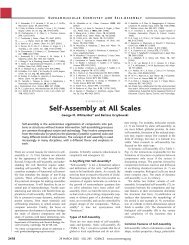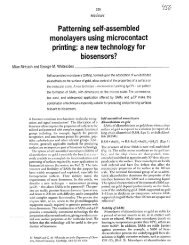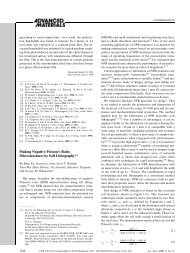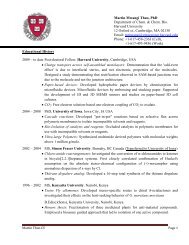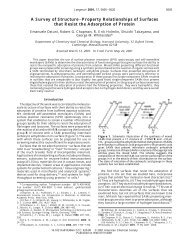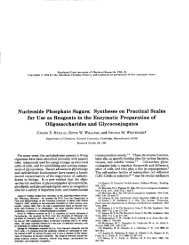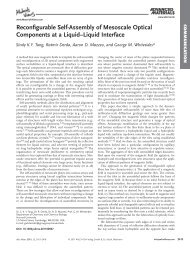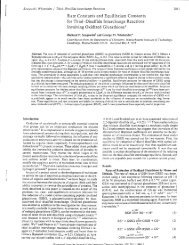Self-Assembled Monolayers of Thiolates on Metals as - Whitesides ...
Self-Assembled Monolayers of Thiolates on Metals as - Whitesides ...
Self-Assembled Monolayers of Thiolates on Metals as - Whitesides ...
Create successful ePaper yourself
Turn your PDF publications into a flip-book with our unique Google optimized e-Paper software.
1130 Chemical Reviews, 2005, Vol. 105, No. 4 Love et al.<br />
Figure 8. (a) Schematic representati<strong>on</strong> <str<strong>on</strong>g>of</str<strong>on</strong>g> the different<br />
growth modes <str<strong>on</strong>g>of</str<strong>on</strong>g> PbS nanocrystals in the presence <str<strong>on</strong>g>of</str<strong>on</strong>g><br />
different surfactants. (Reprinted with permissi<strong>on</strong> from ref<br />
78. Copyright 2003 Wiley-VCH.) (b) TEM image <str<strong>on</strong>g>of</str<strong>on</strong>g> rodb<strong>as</strong>ed<br />
PbS multipods formed in the presence <str<strong>on</strong>g>of</str<strong>on</strong>g> dodecanethiol<br />
at 140 °C for 5 min. (c) TEM image <str<strong>on</strong>g>of</str<strong>on</strong>g> star-shaped<br />
nanocrystals <str<strong>on</strong>g>of</str<strong>on</strong>g> PbS formed in the presence <str<strong>on</strong>g>of</str<strong>on</strong>g> dodecanethiol<br />
at 230 °C. (d) TEM image <str<strong>on</strong>g>of</str<strong>on</strong>g> cubic PbS nanocrystals formed<br />
in the presence <str<strong>on</strong>g>of</str<strong>on</strong>g> dodecylamine. (b-d) (Reprinted with<br />
permissi<strong>on</strong> from ref 77. Copyright 2002 American Chemical<br />
Society.)<br />
Scheme 4. Three Comm<strong>on</strong> Strategies for Tailoring<br />
the Compositi<strong>on</strong> <str<strong>on</strong>g>of</str<strong>on</strong>g> the SAM <strong>on</strong> Nanoparticles a<br />
a Each <strong>on</strong>e is discussed in the text in the secti<strong>on</strong> indicated in<br />
the scheme.<br />
For example, depending <strong>on</strong> the c<strong>on</strong>centrati<strong>on</strong> <str<strong>on</strong>g>of</str<strong>on</strong>g><br />
dodecanethiol present during formati<strong>on</strong> and <strong>on</strong> the<br />
temperature <str<strong>on</strong>g>of</str<strong>on</strong>g> the reacti<strong>on</strong>, the shape <str<strong>on</strong>g>of</str<strong>on</strong>g> PbS (a<br />
semic<strong>on</strong>ductor) nanocrystals changes from the equilibrium<br />
cubic habit (bounded by six {100} faces), to<br />
starlike crystals, to el<strong>on</strong>gated rods and branched<br />
structures (bounded by {111} faces) (Figure 8). 77,78<br />
This effect is specific to thiols: growth in the presence<br />
<str<strong>on</strong>g>of</str<strong>on</strong>g> dodecylamine, a ligand with lower affinity for PbS,<br />
yields <strong>on</strong>ly PbS cubes. These results suggest that the<br />
thiols have a higher affinity for the {111} faces,<br />
where the sulfur can be positi<strong>on</strong>ed equidistant from<br />
three Pb(II) atoms, than for the {100} faces, where<br />
the sulfur can <strong>on</strong>ly be positi<strong>on</strong>ed equidistant from<br />
two Pb(II) atoms.<br />
6.2. Strategies for Functi<strong>on</strong>alizing Nanoparticles<br />
with Ligands<br />
There are three comm<strong>on</strong> strategies for tailoring the<br />
compositi<strong>on</strong> <str<strong>on</strong>g>of</str<strong>on</strong>g> the SAM <strong>on</strong> nanoparticles and the<br />
functi<strong>on</strong>al groups exposed at the SAM-solvent interface<br />
(Scheme 4). They are (1) forming the nanoparticles<br />
directly in the presence <str<strong>on</strong>g>of</str<strong>on</strong>g> ω-functi<strong>on</strong>alized<br />
thiols, (2) exchanging an existing ligand for an<br />
ω-functi<strong>on</strong>alized thiol, and (3) modifying the original<br />
thiol covalently by an interfacial reacti<strong>on</strong>. We address<br />
each <str<strong>on</strong>g>of</str<strong>on</strong>g> these approaches in the following secti<strong>on</strong>s.<br />
6.2.1. Formati<strong>on</strong> <str<strong>on</strong>g>of</str<strong>on</strong>g> Nanoparticles in the Presence <str<strong>on</strong>g>of</str<strong>on</strong>g><br />
Thiols<br />
The ω-functi<strong>on</strong>alities <str<strong>on</strong>g>of</str<strong>on</strong>g> the thiols used to protect<br />
nanoparticles determine what solvents (aqueous or<br />
organic) can disperse the particles. Some alkanethiols<br />
can tolerate the reductive c<strong>on</strong>diti<strong>on</strong>s used to prepare<br />
nanoparticles and, therefore, can be used to protect<br />
the nanoparticles during formati<strong>on</strong> (Scheme 4). For<br />
example, in the two-ph<strong>as</strong>e Brust-Schiffrin method,<br />
n-alkanethiols and other organic soluble thiols, including<br />
a BINOL (1,1′-bi-2-naphthol) derivative, 453<br />
have been used. 57,92,454<br />
Water-soluble nanoparticles are desirable for biological<br />
applicati<strong>on</strong>s, and many preparati<strong>on</strong>s have<br />
been developed that use thiols with hydrophilic, polar<br />
headgroups. For example, mercaptosuccinic acid can<br />
serve <strong>as</strong> a stabilizer during borohydride reducti<strong>on</strong> <str<strong>on</strong>g>of</str<strong>on</strong>g><br />
HAuCl4 to give 1-3 nm, water-dispersible gold nanoparticles<br />
that are stabilized by the charge-charge<br />
repulsi<strong>on</strong> <str<strong>on</strong>g>of</str<strong>on</strong>g> the carboxylate i<strong>on</strong>s. 447 Glutathi<strong>on</strong>e, 455<br />
tiopr<strong>on</strong>in (N-2-mercaptopropi<strong>on</strong>yl-glycine), 456 coenzyme<br />
A (CoA), 456 trimethyl (mercaptoundecyl)amm<strong>on</strong>ium,<br />
457 and thiolated derivatives <str<strong>on</strong>g>of</str<strong>on</strong>g> PEG 458 have<br />
all been used <strong>as</strong> thiol-b<strong>as</strong>ed water-soluble stabilizers<br />
during the formati<strong>on</strong> <str<strong>on</strong>g>of</str<strong>on</strong>g> gold nanoparticles with a<br />
variety <str<strong>on</strong>g>of</str<strong>on</strong>g> reductants.<br />
6.2.2. Ligand-Exchange Methods<br />
Displacement <str<strong>on</strong>g>of</str<strong>on</strong>g> <strong>on</strong>e ligand for another is a sec<strong>on</strong>d<br />
strategy for modifying the organic surface <str<strong>on</strong>g>of</str<strong>on</strong>g> nanoparticles<br />
after their formati<strong>on</strong> (Scheme 4). 459,460 These<br />
so-called “ligand-exchange” methods are particularly<br />
useful if the desired ligand is not compatible with the<br />
highly reductive envir<strong>on</strong>ment required for forming<br />
nanoparticles or if the desired ligand is particularly<br />
valuable (or simply not commercially available) and<br />
cannot be used in the excess necessary for stabilizati<strong>on</strong><br />
during synthesis. Simple thiols can be exchanged<br />
for more complex thiols 459 or disulfides. 91,461 Ligand<br />
exchange is <str<strong>on</strong>g>of</str<strong>on</strong>g>ten used to synthesize poly-hetero-ωfuncti<strong>on</strong>alized<br />
alkanethiol gold nanoparticles via<br />
either simultaneous or stepwise exchange. 462,463 There<br />
are also several recent reports <str<strong>on</strong>g>of</str<strong>on</strong>g> solid-ph<strong>as</strong>e placeexchange<br />
reacti<strong>on</strong>s with thiol ligands displayed <strong>on</strong><br />
Wang resin beads. 464,465<br />
Thiols can displace other ligands weakly bound to<br />
gold (e.g., phosphines and citrate i<strong>on</strong>s); procedures<br />
b<strong>as</strong>ed <strong>on</strong> exchange are used to functi<strong>on</strong>alize large<br />
gold nanoparticles (>5 nm) that cannot be formed<br />
directly with a protective layer <str<strong>on</strong>g>of</str<strong>on</strong>g> thiols. 466 For<br />
example, dodecanethiol h<strong>as</strong> been used to extract gold<br />
nanoparticles from water (where they were formed<br />
via <strong>as</strong>corbic acid reducti<strong>on</strong> in the presence <str<strong>on</strong>g>of</str<strong>on</strong>g> CTAB)<br />
into organic solvents. 438,446 Caruso and co-workers<br />
also dem<strong>on</strong>strated the extracti<strong>on</strong> <str<strong>on</strong>g>of</str<strong>on</strong>g> gold nanoparticles<br />
from toluene into aqueous soluti<strong>on</strong>s; this method<br />
relies <strong>on</strong> the displacement <str<strong>on</strong>g>of</str<strong>on</strong>g> hydrophobic n-alkanethiols<br />
with water-soluble thiols. 435,446




